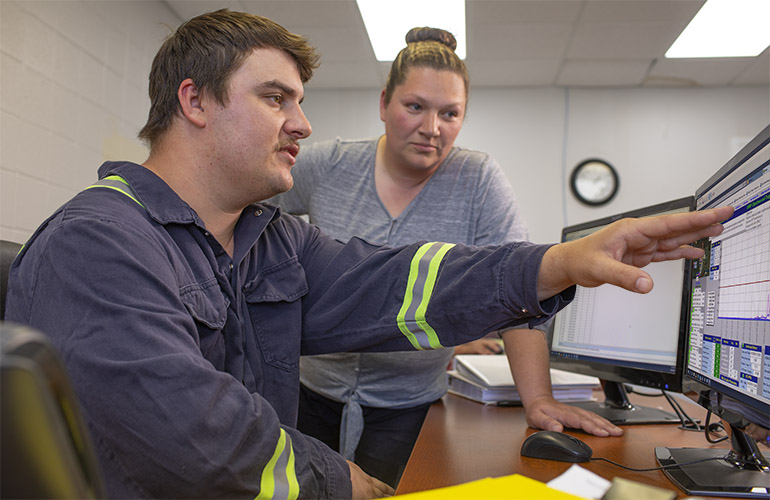Evolution of Our Environmental Management
16 Aug 2019

Operating in a manner that protects the environment is one of our guiding principles. For the past 10 years, we have reported on our efforts to reduce our environmental footprint in our annual Sustainability Report. This has been a decade of focus, innovation and purposeful investments.
“Since 2009, we’ve invested approximately $450 million in efforts aimed at reducing air emissions, improving water quality and lessening our environmental impact at our mines and mills, as well as at our Resource Recycling facility,” said Michael Montgomery, who was promoted to vice president – environmental affairs in 2019. “Our data shows that these investments have significantly reduced our air emissions and improved the quality of water discharged from operations.”
Highlights from Our Southeast Missouri Mines and Mills:
- Five water treatment plants: We invested nearly $73 million over five years to construct water treatment plants at our mines and mills. The plants use a chemical process to clean water from our operations before it is released to the environment.
- Four concentrate enclosures: These buildings store lead concentrates after the milling process. We added negative pressure ventilation systems to our buildings, which reduce the potential of fugitive emissions.
- Geothermal HVAC: We installed geothermal heating, ventilation and air conditioning (HVAC) systems at Brushy Creek Mine and Mill’s building and the SEMO central office. The geothermal system uses 25% to 50% less electricity than conventional heating and cooling systems, reducing overall carbon dioxide and greenhouse gas emissions.
- Waste management facilities: An employee-led effort to redefine our procedures for managing waste resulted in the installation of new hazardous and non-hazardous waste storage areas at all mine and mill operations.
- ISO 14011 certifications: We established new processes and systems to achieve International Organization for Standardization (ISO) 14001 environmental management certification at our six mines and four mills. These certifications include ongoing third-party audits of our environmental procedures.
Highlights from the Resource Recycling Facility:
- Dry lime scrubber: In anticipation of more stringent National Ambient Air Quality Standards (NAAQS), Resource Recycling built a dry lime scrubber that successfully reduced air emissions. Today, our Resource Recycling SO2 air monitors report average emissions around 40 parts per billion, approximately half of the EPA’s requirement (75 parts per billion).
- Building enclosures and new baghouses: We took measures to enclose much of the plant and install six new baghouses and ventilation systems to collect lead particles and other airborne materials before releasing air outside.
- Water treatment plant: We constructed a new water treatment plant to capture and treat wastewater from the recycling process. We also installed a closed-loop water system for several of our processes, which reduced our consumption of fresh water.
“We have invested heavily in environmental projects over the past 10 years,” said Michael. “Regulatory requirements continue to tighten so we must not only focus on today’s requirements but also anticipate future standards.”
Improvements in Data Management

It’s been said you can’t manage what you don’t measure, so data-tracking systems have been critical to guiding our environmental journey. Over the past decade, we have refined our data gathering process to add efficiency to our environmental efforts. Most recently, Resource Recycling added a new environmental data management tool to help us more easily collect data, make comparisons and adjust our operations for improved environmental and operational performance.
“We maintain years of emissions data on our plant,” said Maggie Crocker, environmental compliance manager at Resource Recycling. “In the past, creating new reports from an old database required an outside consultant and took weeks. With the new tool, I can pull the data myself in under an hour.”
The new data management tool, an environmental historian, pulls data directly from hundreds of instruments and monitors throughout the facility. Supervisors and managers can access real-time information remotely, enabling them to adjust our operations quicker.
“With this new platform, we can pull detailed reports and analyze production data alongside environmental data, so we can more easily evaluate how our performance in one area impacts the other,” said Maggie. “This sets us up for the future by helping operations understand the potential environmental impact of decisions made.”
In addition, we’ve increased the functionality of our Environmental Task Management System (ETMS), which we implemented 10 years ago to help track the thousands of environmental requirements that needed ongoing monitoring at our SEMO and Resource Recycling operations. Now we can manage the majority of our inspections through ETMS as well, which takes less time and ensures documentation is electronically filed and saved.
Improved environmental data systems have helped Doe Run keep ISO 14001 certifications at all six mine sites, four mill sites and Resource Recycling. These certifications recognize that our operations have implemented environmental management programs for managing our impact and improving our environmental performance. Read more about ISO certifications here.


